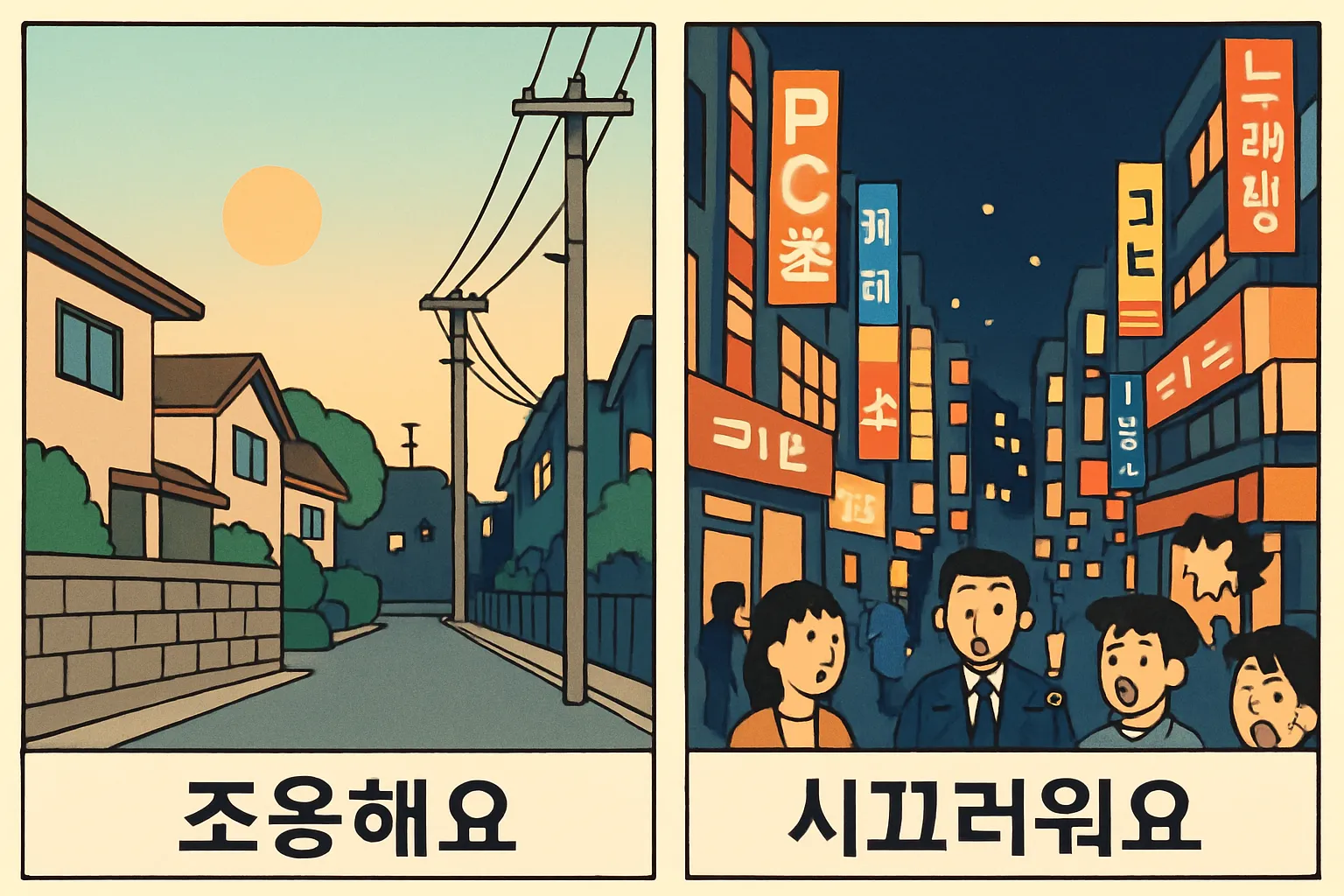Unlocking Nuance: A Masterclass in Comparing Korean Poetry
Hello! Welcome back to [Maeil Hangeul], your guide to mastering the Korean language!
Are you ready to move beyond conversational fluency and dive into the heart of Korean culture and intellect? Today, we’re tackling a skill that will truly set you apart: comparing and analyzing contemporary Korean poetry. This isn’t just for literature majors; it’s for anyone who wants to understand the subtle emotions and complex ideas that shape the modern Korean psyche. In Korea’s vibrant literary scene, poets often engage in a silent dialogue, tackling similar societal issues or universal emotions from unique angles. Understanding this interplay is like having a backstage pass to the Korean intellectual landscape. Let’s learn how to read between the lines, just like a native!
Core Analytical Expressions
Here are four essential terms that are the keys to unlocking poetic meaning.
- 1. 시적 화자 (Sijeok Hwaja)
- Pronunciation [Romanized]: Si-jeok Hwa-ja
- English Meaning: Poetic Speaker / Persona
- Detailed Explanation: This is one of the most crucial concepts in poetry analysis. The sijeok hwaja is the “voice” of the poem, the character or perspective from which the poem is told. It is not the poet themselves! When comparing two poems, ask yourself: Who is speaking? Is the speaker a child, an observer, a participant? Is their perspective personal or detached? Comparing the hwaja across poems on the same theme reveals dramatically different interpretations.
- 2. 심상 (Simsang)
- Pronunciation [Romanized]: Sim-sang
- English Meaning: Imagery
- Detailed Explanation: Simsang refers to the use of language to evoke sensory experiences (sight, sound, smell, taste, touch). It’s how a poet “shows” rather than “tells.” When analyzing, look at the kinds of imagery used. Does one poet use cold, metallic visual imagery (시각적 심상) to describe the city, while another uses olfactory imagery (후각적 심상) of street food to evoke a sense of nostalgia? The choice of simsang is a direct window into the poem’s emotional core.
- 3. 함축적 의미 (Hamchukjeok Uimi)
- Pronunciation [Romanized]: Ham-chuk-jeok Ui-mi
- English Meaning: Connotative Meaning / Implication
- Detailed Explanation: This refers to the implied, suggested, or emotional meaning of a word, beyond its literal dictionary definition (which is called 직설적 의미). Advanced analysis hinges on understanding this. For example, the word ‘강’ (river) can literally mean a body of water, but its hamchukjeok uimi could be the flow of time, separation, or history. Comparing how two poets use the same word to create different connotative meanings is a high-level analytical skill.
- 4. 어조 (Eojo)
- Pronunciation [Romanized]: Eo-jo
- English Meaning: Tone / Voice
- Detailed Explanation: The eojo is the speaker’s attitude toward the subject or the audience. It’s the overall mood or feeling conveyed by word choice, syntax, and rhythm. Is the tone critical (비판적), melancholic (애상적), longing (그리운), or cynical (냉소적)? Identifying and comparing the eojo is key to understanding the poet’s ultimate message.
Example Dialogue
Let’s see how two literature students, Jinsu and Mina, might use these terms to discuss two famous poems about urban life.
A (Jinsu): 미나 씨, 김광균 시인의 ‘와사등’과 정호승 시인의 ‘서울의 예수’를 비교하는 과제, 어떻게 생각해요? 둘 다 도시의 고독을 다루지만 느낌이 사뭇 다르지 않아요?
Mina, what do you think about the assignment comparing Kim Kwang-kyun’s ‘Gaslight’ and Jeong Ho-seung’s ‘Jesus of Seoul’? Both deal with urban loneliness, but the feeling is quite different, isn’t it?
B (Mina): 맞아요. 김광균의 시적 화자는 도시를 관조하는 느낌이라면, 정호승의 화자는 소외된 이들과 연대하려는 의지가 보여요. 특히 심상을 비교해 보면 차이가 명확하죠.
Exactly. While Kim’s poetic speaker seems to be a detached observer of the city, Jeong’s speaker shows a will to stand in solidarity with the marginalized. The difference is especially clear when you compare the imagery.
A (Jinsu): 정말 그렇네요. ‘와사등’의 ‘슬픈 신호’ 같은 시각적 심상은 차갑고 기계적인 느낌을 주는데, ‘서울의 예수’에서는 ‘굶주린 이들’이라는 직접적인 표현을 통해 함축적 의미보다는 현실을 고발하는 어조가 강하게 느껴져요.
That’s so true. The visual imagery in ‘Gaslight’, like the ‘sad signal’, gives a cold, mechanical feeling. But in ‘Jesus of Seoul’, the direct expression ‘the hungry ones’ creates a strong tone of social critique rather than relying on connotative meaning.
B (Mina): 네, 바로 그 점이 두 시의 주제 의식을 가르는 핵심인 것 같아요.
Yes, I think that’s the core point that differentiates the thematic consciousness of the two poems.
Culture Tip & Deeper Dive
This kind of deep reading isn’t just for academics! This analytical approach is common in popular Korean book clubs (독서 모임) and on literary YouTube channels (북튜버).
A very popular trend among the younger generation in Korea is ‘필사’ (pil-sa), the meditative practice of hand-copying poems and literary texts. People often share photos of their handwritten poems on Instagram, frequently adding a short analysis comparing the eojo (tone) of the poem to another they’ve read. It’s a beautiful, tangible way modern Koreans connect with their literary heritage.
Pro Tip: When discussing poetry with Korean friends, try moving beyond simple phrases like “좋은 시예요” (It’s a good poem). Elevate your conversation by saying something like, “이 시는 시적 화자의 담담한 어조가 인상 깊었어요” (I was impressed by the calm tone of the poetic speaker in this poem). This will show your deep engagement and make you sound like a true connoisseur!
Wrap-up & Practice Time!
Today, we’ve learned four powerful analytical terms—시적 화자, 심상, 함축적 의미, and 어조—to elevate our understanding of Korean poetry. By comparing these elements, you can unlock profound layers of meaning and appreciate the artistry of Korean poets on a whole new level.
Now it’s your turn to be the critic!
- Fill in the blank:
이 시는 냉소적인 ( ________ )를 통해 현대 사회의 모순을 날카롭게 지적하고 있다.
(This poem sharply points out the contradictions of modern society through its cynical ____.)
Answer: 어조 -
Your Turn to Analyze:
Find two Korean poems about ‘the sea’ (바다). In a few sentences, briefly compare the 심상 (imagery) used in each. How do they create different feelings about the same subject?
Ready to try? Share your analysis for question #2 in the comments below using the expressions we learned today! We can’t wait to read your brilliant insights






